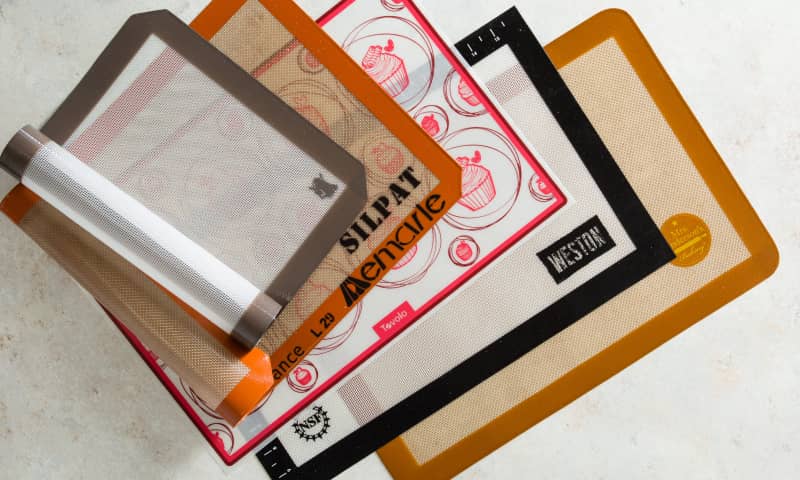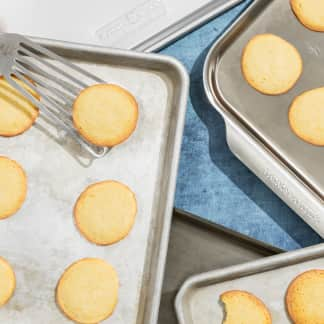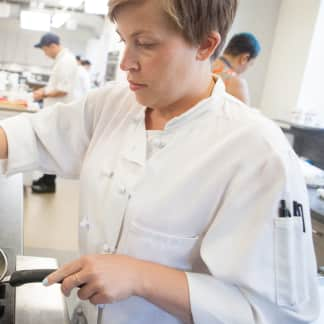Silicone baking mats are reusable alternatives to parchment paper: Pop one into a baking sheet and you instantly have a nonstick baking surface that you can use, wash, and reuse. Made of silicone embedded with heat-conducting fiberglass or nylon fiber mesh, these nonstick mats were originally intended for use in restaurant kitchens. But since they've become increasingly popular with home cooks over the past decade, we decided it was time for a fresh look. We bought five mats priced, including our former winner, the DeMarle Silpat U.S. Half-Size Non-Stick Silicone Baking Mat. We pitted the mats against our favorite parchment paper, King Arthur Flour Parchment Paper 100 Half-Sheets, using them to bake multiple batches of tuile cigars, sugar cookies, and chocolate chip cookies. We also tested them against an unlined rimmed baking sheet, roasting potatoes and salmon.

Are Silicone Baking Mats Better Than Parchment?
The mats certainly have advantages over parchment paper. They're easy to slip into a baking sheet, and their comparative weight (60 to 117 grams) helps them stay put better than even our favorite parchment sheets (4 grams). This comes in handy when you're working with melted chocolate or caramel or need to spread out clingy batters such as the one for our Tuile Cigars. With the occasional exception of the lightest-weight mat, we never had to worry about the offset spatula pulling the mat up, as sometimes happens with parchment. And because these mats usually sit flat, they produced tuiles with perfectly smooth undersides—not always the case with parchment, under which air bubbles can form, resulting in wrinkles or seams in the finished tuiles. (We've also found that creased or curled parchment can affect the appearance of cookies and cakes.)

Better still, the mats have all the nonstick benefits of parchment—and then some. This made it a breeze to remove cookies and skin-on salmon fillets (in contrast, salmon cooked on a bare baking sheet sometimes stuck, requiring us to scrape it off). In fact, the mats' nonstick surfaces are so slick that they repel fat, which pooled around and under our roasted potatoes and ensured that they browned more evenly than they did on the bare baking sheet. One thing to note: Because the mats are so slick, some types of cookies spread out more on them; for example, chocolate chip cookies baked on the mats were about ¼ inch wider than those cooked on parchment, and their edges browned more deeply, resulting in a slightly crispier final product.

The Best Silicone Baking Mat
The mats were all durable and performed similarly, regardless of manufacturing differences or exact composition. Our preferences boiled down to size and ease of cleanup. All the mats could be used with our favorite rimmed baking sheet, which measures 16½ by 11½ inches, but one was a bit too small (reducing the usable surface area) and another was a bit too long, so cookies placed near the short ends of it took on the mat's upward curve. Three mats fit the baking sheet perfectly, and of those, we preferred the two slightly heavier ones (each weighing more than 100 grams), as they stayed put better.

Choosing between these top two mats came down to cleanup: We preferred the model that was dishwasher-safe. Over time, all the mats in our testing accumulated some residual fats and oils, just as their manufacturers said they would. They also retained odors. After we used the mats to roast salmon, they smelled distinctly of fish in the oven when used to bake sugar cookies; the cookies themselves also tasted faintly fishy to a few testers. Mats that were dishwasher-safe generally felt cleaner and less sticky, and they had less-pronounced odors.
If you bake a lot and like the idea of a reusable mat or prefer not to fuss with parchment, a silicone baking mat might be a nice addition to your kitchen. Our previous winner, the DeMarle Silpat U.S. Half-Size Non-Stick Silicone Baking Mat, is still our favorite. This mat performs beautifully, fits perfectly in a baking sheet, and is dishwasher-safe.
The Tests
- Bake store-bought sugar cookie dough on new mat to evaluate for any native odors
- Bake Tuile Cigars
- Make Duck Fat–Roasted Potatoes
- Bake five batches of Perfect Chocolate Chip Cookies to evaluate durability and grease buildup
- Make Oven-Roasted Salmon
- Bake another batch of store-bought sugar cookie dough to evaluate for any residual odors
- Wash 10 times according to manufacturer's instructions
How We Rated
- Performance: We evaluated how well and consistently the mats baked the cookies and roasted the potatoes and salmon.
- Ease of Use: We evaluated how easily the mats fit in our winning baking sheet, how stable they were within the sheet, and how well they resisted odors and grease buildup.






